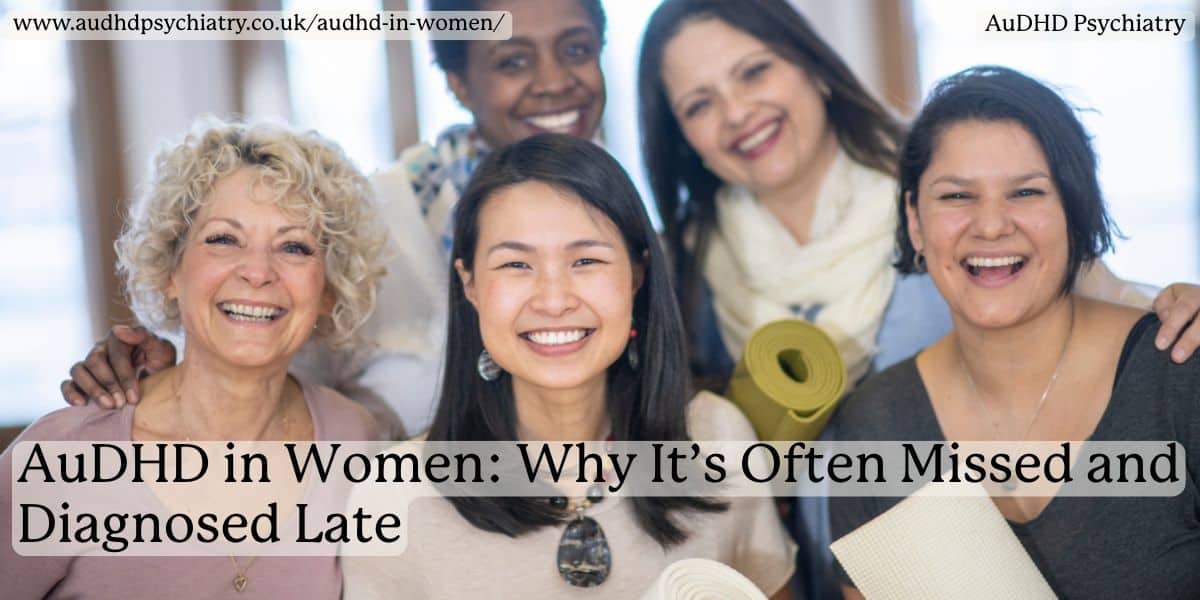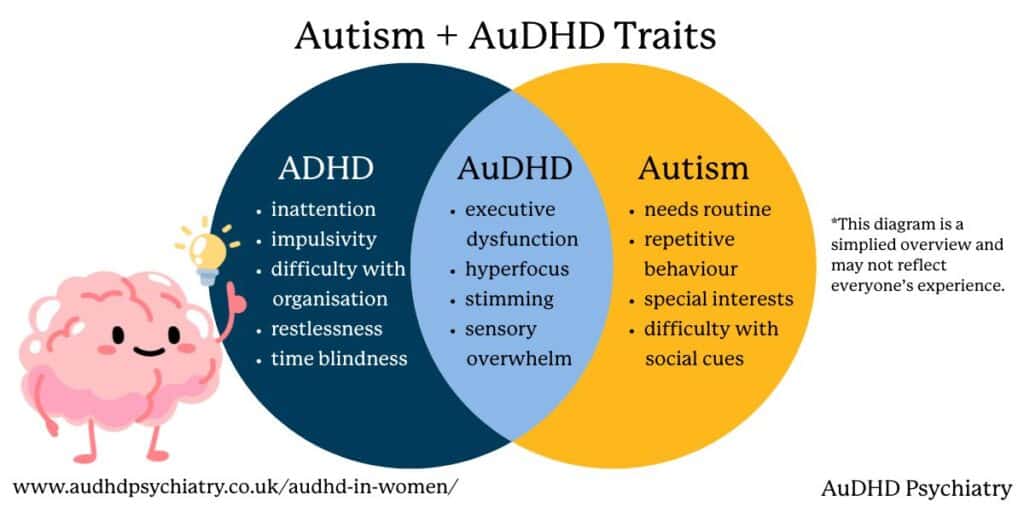
Understanding AuDHD in Women
If you have spent years feeling different from other women, and have been trying to keep up with social expectations, masking your exhaustion, feeling overwhelmed by sensory stimuli (or lack thereof) which others cannot perceive, you may want to consider getting tested for AuDHD. AuDHD is autism and ADHD manifesting in the same individual, which is especially pertinent to women who feel both very perceptive and, simultaneously, chronically overloaded.
More women should be educated to recognise AuDHD and access support to combat internalised stigmatisation, which may lead someone to believe they are just “too sensitive” or “not trying hard enough.” Girls learn masking and mimicry very early, and because AuDHD in women often present the same during childhood, in society’s eyes, they are “fine” until some things go wrong, like burnout, anxiety, or other chronic mental illnesses.
This article will talk about relevant symptoms of AuDHD in women, underdiagnosis, and how early detection is critical to living a more true and authentic life. If these struggles align with your challenges and you’d like to take a combined AuDHD assessment, we’re here to help you every step of the way.
Before discussing AuDHD, let’s talk about the two conditions involved: Autism Spectrum Disorder and Attention Deficit Hyperactivity Disorder (ADHD).
How Is Autism Represented in Women?
Autism is diagnosed differently among women and girls, and here’s why women go many years without a diagnosis. Autistic women and girls may not display the external behaviours that people relate autism to, and instead may show more internal behaviours that could be interpreted as anxiety, shyness, or sensitivity. Understanding the ways autism may show in women can allow families, individuals, and especially clinicians to identify these patterns that often go unrecognised.
Social Challenges
Autistic girls have developed exceptional social skills, often knowing how to socially camouflage to fit into a social setting. Many girls do not socially withdraw or show overt social difference; rather they learn to watch, mimic and absorb the actions of people around them. This often makes autism even more difficult to spot, even if social communication and processing are a struggle.
Some common traits reported include challenges in understanding facial expressions, social cues, and conversational exchanges that seem rigid and structured, as if a person is reading from a script. These traits may contribute to a mask of social confidence, masking the social confusion that underlies such behaviours.
Masking, Camouflaging, and Mimicking Behaviour
Autistic females tend to camouflage and mask, or observe social interactions and imitate them through tones and gestures or even fabricate entire social identities to fend off potential negative judgments. This is considered a form of social skill. It may help autistic people to some extent in social situations, but false pretences eventually take a toll emotionally, as many report burnout, confusion of self-identity, or extreme tiredness after extensive social performance.

Special Interests and “Socially Acceptable” Passions
Autistic girls tend to gravitate towards socially acceptable special interests like animals, literature, or even celebrities and psychology. The depth of the interest in these topics, however, is undeniably deeper than neurotypical interests, and it is very common for people to overlook this trait as a sign of autism.
Sensory Processing Differences and Sensory Overload
Many autistic females have to deal with the effects of sensory hypersensitivity, which may include the inability to function in the presence of bright lights, sudden loud noises, strong perfumes, rough textures of fabric, or overpopulated social spaces. The effects of these sensory hypersensitivities eventually create a situation called sensory overload, which may result in emotional shutdown or a state of being easily agitated.
How Is ADHD Represented in Women?
ADHD in women differs from the stereotype of a hyperactive small boy who cannot sit still. For women, ADHD manifests as chronic overwhelm, internal restlessness, the struggle to focus, emotional intensity, and a constant fight to concentrate, and even after considerable effort, focus still cannot be achieved. Because these traits appear subtle, many women characteristically receive a late ADHD diagnosis as adults.
What ADHD Looks Like for Women
In women, ADHD usually fits in the box of inattentive ADHD. The common symptoms are:
- Forgetfulness
- Misplacing things
- Extreme zoning out
- An inability to finish tasks
Even if a woman seems calm and composed, there’s a chance that she might have a storm of thoughts in her mind, causing a cognitive gap between what’s in their mind and what’s outward, leading to a lot of frustration and self-blame. In the same way that internal hyperactivity presents differently in boys as visible outward fidgeting, emotional restlessness and rumination, and excessive overthinking, internal hyperactivity presents as chronic fidgeting.
Emotional Dysregulation and Sensitivity
Women commonly experience “emotional flooding”, a term used to describe yery strong emotional reactions. Emotional dysregulation is visibly seen as frustration, tears, and zoning out when there’s emotional overwhelm. These symptoms are not weaknesses, cause they correlate to attention regulation issues, working memory, and control over impulses.
If you want to know the details of what that looks like, please look into ADHD and Emotional Dysregulation.
Hyperfocus vs Distraction
ADHD women experience splitting phenomena in the form of hyperfocus vs. distractibility. Hyperfocus occurs during non-menial, neurologically stimulating tasks, whereas distractibility occurs during mind-numbing tasks, giving rise to a form of task paralysis. This inconsistency can affect productivity at work, daily routines, and interpersonal relationships.
Executive Dysfunction and Working Memory Challenges
Some women report difficulty with future planning, task prioritisation, and remembering the details. This is often considered executive dysfunction and may lead to developing a reputation for untrustworthiness, even when the person is putting in a great deal of effort. Issues with working memory can also lead to disruptions in conversation, misplacement of objects, and memory lapses around deadlines.
Recognising the traits of adult females with ADHD, particularly those around inattention, is important for obtaining an appropriate diagnosis and care.

What Is AuDHD in Women?
AuDHD is the intersection of autism and ADHD, a particular form of neurodiversity that is separate from either condition alone. Knowing what AuDHD is helps clarify why many women may feel deeply organised but also disordered at times, or highly sensitive but also easily disengaged. These oppositional traits are a reflection of the co-occurrence of autism and ADHD in one person.
Understanding the Autism–ADHD Overlap
Autism and ADHD are separate conditions, but are characterised by some similar traits: differences in attention, heightened sensitivity, difficulty processing emotions, and problems with executive functioning. When either condition is present with the other, the result is an amplification of the traits. For example, the impulsivity associated with ADHD may work counter to the autism’s desire for predictability, causing an internal struggle. This combination often leads to a highly idiosyncratic form of neurodivergence.
How Autistic and ADHD Traits Interact
Constant internal conflict between ADHD traits (stimulation, novelty, and movement seeking) and traits of autism (emphasis upon structure, routines, and sameness) is a common experience among AuDHD women. This form of dissociation can result in a feeling of burnout, indecisiveness, and problems with personal identity. The same internal conflict that causes burnout can also lead to social problems, especially in women practising masking of their autism while being excessive in their social behaviours, as influenced by the traits of ADHD.
Why Women Experience Unique Symptoms
The symptoms of AuDHD commonly appear as internal challenges due to the fact that ADHD and autistic women ‘mask’ their behaviour. With anxiety, fatigue, and sensory sensitivities, many women express their feelings instead of presenting certain behavioural signs. This is a large contributor to the phenomenon of underdiagnosis, misdiagnosis, or delayed recognition.
How AuDHD Presents in Women and Girls (Compared to Men and Boys)
Women tend to feel what some may call a “perpetual internal duel”, with one side being ADHD and the other Autism, with one pushing towards erratic spontaneity and the other tending to pull towards a rigidly structured and routine setting. This tends to create a sort of mental tug-of-war that tends to be very draining. This can result in AuDHD women developing perfectionism in an attempt to gain control and avoid harsh social feedback and criticism.
With social activities, there tend to be a lot of emotional sensitivity and rejection sensitivity. Overwhelm in social settings can be due to loud noises, bright lights, sudden unexpected touches, or strong overlapping scents. Due to these experiences, an AuDHD woman might create her own sensory control strategies. These can show in the form of avoiding crowds, adjusting clothing textures, or relying on predictable routines.

Diagnostic Challenges and Misdiagnosis
Because AuDHD does not align with the typical male presentation, many women are incorrectly diagnosed with borderline personality disorder, bipolar disorder, generalised anxiety disorder, and depression. Experts may pay attention to the emotional outbursts rather than the neurological origins. Aspects of gender socialisation can also hinder women from getting an official diagnosis. For example, girls are supposed to be socially adept, pliable, and emotionally controlled.
As we’ve mentioned, these can force AuDHD women to mask, leading to prolonged chronic stress and alienation.
AuDHD Women Recognising Each Other
Many women report that people with AuDHD have a unique ability to recognise other AuDHD individuals. They share a unique mix of emotional and social intelligence, extreme empathy, pattern-matching, and social exhaustion. The combination of these traits forms a social bond characterised by deep and meaningful relationships built on empathy and mutual social understanding.
Understanding these specific issues might help avoid self-judgment, aiding in obtaining an accurate diagnosis, and facilitating the construction of a more sustainable lifestyle where authenticity is prioritised. If you’re experiencing these attributes and would like to find answers through an AuDHD assessment, schedule a consultation with us. You can choose a time and date that works perfectly with your own schedule, as we also offer evening consultations.
Social and Relationship Impacts of AuDHD in Women
AuDHD impacts the way women manage their friendships and family relationships, affects their experience in social settings, and manages their romantic relationships. Females often report navigating social settings with increased vigilance, constant self-surveillance, and anxiety about social and emotional signal misinterpretation.
Social Experiences and Communication Differences
For women with AuDHD, social situations are often experienced as being intense and may cause social anxiety. They may struggle to read facial expressions, shifts in tone, and the social order of a situation. This can lead to a phenomenon in which the individual continues to think about and analyse social interactions for a prolonged period of time. Hypervigilance can develop in which the person observes social situations with great detail and effort in order to avoid missteps. On the other hand, some people may opt to disengage to prevent sensory and emotional overwhelm.
Masking plays a major role. Many women with autism learn to imitate social behaviours such as eye contact and smiling in a social situation, while appearing to be self-assured, all the while feeling internal disorientation. This contributes to prolonged exhaustion and fatigue as a result of social situations. This can be especially true when environments are highly stimulating due to the presence of loud voices, strong lighting, and other unpredictable sensory input.
Emotional Experiences and Internal Processing
AuDHD women experience high levels of emotion. Mood changes and emotional responses can be very rapid. Reactions may go as far as becoming disproportionate for even slight scenarios. Internal rumination is common as these women may ruminate on conversations, obsess over misunderstandings, and severely overthink things when they become too overwhelmed.

Romantic Relationships
Emotional closeness in a relationship can be affected by how each partner communicates. AuDHD women may need clear language, a structured approach, or more reassurance, especially in the case of having to set some kind of sensory boundaries. Physical contact can be soothing and contribute to a sense of safety, but it can also be overwhelming, depending on how much sensory input has been received.
Partners often mistake this for inconsistency when, in fact, it can be due to sensory overload or having a dysregulated nervous system. Emotional exhaustion can accumulate and cause burnout, which is the situation for many AuDHD women who, after a few months or years of masking, experience an emotional crash, as discussed in ADHD Burnout.
Once these relationships and emotional responses are understood, it allows women to relate to others and to themselves in kinder and more compassionate ways.
Daily Life, Executive Function Hormones, and Burnout
AuDHD does impact everyday life on many levels, including the practical, emotional, and sensory. It is common among women to describe life as having to constantly manage an overactive mind, a lack of mental energy, and an unpredictable nervous system. None of these patterns is due to character flaws, but rather is due to the interplay between the executive function, the sensory processing system, and the hormonal system.
Executive Functioning and Time Management
AuDHD women face executive function challenges including:
- Time management challenges
- Missing appointments and misplacing things
- Difficulty in changing focus
- Becoming stuck when feeling overwhelmed
- Difficulty in planning and/or decomposition of tasks
This can result in the bare necessities of daily life feeling like an impossible burden. Technologies and techniques that provide structure, like habit stacking and ADHD tools for daily tasks, can yield tangible benefits.
Sensory and Daily Living Challenges
Some AuDHD women report extreme cases of sensory overload. Many find the following sensory tools comforting:
- Weighted blankets
- Noise-cancelling earphones
- Visual aids
- Predictable environments with/without structured activities
Even mundane daily activities can seem erratic and unproductive. They might be easy and feel like a breeze one day, yet be impossible the next. This is often due to the regulatory state of attention and is not caused by a lack of motivation.
Hormonal Influences on AuDHD Symptoms
There are significant effects on the autistic and ADHD traits due to a woman’s changing hormones, as well as the challenges of PMDD or PMS; some women report a heightened emotional sensitivity; sensory overload during the postpartum period is common. Around the time of menopause, the dominant estrogen is lower, and women often become more distracted and experience more ADHD traits. These observations indicate the hormonal cycle’s influence on energy, working memory, and emotional control. Self-care tends to work best when coordinated with routine hormonal cycles.
AuDHD Burnout
Burnout experienced by AudHD women is complex. When it comes to AuDHD, there is Autistic Burnout, which includes sensory collapse and withdrawal, and there is ADHD Burnout, which involves emotional exhaustion and mental fatigue. When people are masking traits from both spectrums, it radically speeds up the process.
The most effective support techniques involve sensory breaks, reduced masking, and the implementation of therapeutic coping mechanisms. Allied health professionals may also recommend some unstructured time to rest so that the nervous system can reset itself.
Diagnosis, Treatment, and Support for AuDHD in Women
When women receive a diagnosis for AuDHD, they often report experiencing a huge sense of relief and clarity. Gaining a better understanding of the assessment process and the support that accompanies it can provide women with peace of mind and help them feel empowered to take the next steps.

Taking an AuDHD Assessment with AuDHD Psychiatry
The steps involved in our assessment process are as follows:
Step 1: Book Your Combined ADHD and Autism Assessment
Your AuDHD assessment begins as soon as you book. Women are often missed or misdiagnosed due to masking, so we start with a short set of forms that highlight your history, sensory profile, routines, overwhelm, strengths, and challenges. This makes the assessment smoother and ensures we focus on what truly matters for women with suspected AuDHD.
Step 2: Autism Diagnostic Interview
You’ll meet with a clinician experienced in identifying Autism in adult women. This interview explores communication, sensory sensitivities, masking, burnout, emotional load, and the subtle coping strategies women often develop. We pay close attention to the internal experiences that are frequently overlooked.
Step 3: Informant Interview
We speak with someone who knows you well to gain a fuller picture of lifelong patterns. Because many women learn to compensate or appear “fine” externally, this perspective helps confirm long-term traits, strengths, and challenges.
Step 4: ADHD Diagnostic Interview
This session focuses on how ADHD presents for you—often internally and less visibly in women. We explore focus, planning, emotional regulation, overwhelm, motivation, and impulsivity, ensuring ADHD isn’t masked by Autism traits or vice versa.
Step 5: Diagnosis, full report and next steps
You receive a clear combined diagnostic outcome and a detailed report recognised by GPs, workplaces, and universities. Your plan includes tailored guidance, treatment options, and support specific to how AuDHD shows up in women.
Building Support Systems
Different kinds of support, if offered, contribute to creating a fostering environment for most women without masking. It may include:
- Local or online support groups
- AuDHD-focused online communities
- Supportive workplace arrangements
- Advocacy for appropriate support in healthcare and social settings
AuDHD in Women: Conclusion
Misdiagnosis of AuDHD in women is common due to the fact that many women have learned to mask their symptoms from an early age. This leads to a lifetime of internal overwhelm, sensory fatigue, emotional burnout, and executive dysfunction. It’s also due to women’s AuDHD traits not conforming to society’s expectations of what the autistic or ADHD experience “should” be.
All of the subtle, internalised ADHD symptoms, burnout, and emotional can force AuDHD women to self-blame. They may need warmth, validation, and appropriate resources. When women describe their patterns for the first time, they may report a sense of being ‘seen’ that they have never experienced. Diagnosis is critical as it gives you a chance to lessen the friction in your life. Emotional regulation, interpersonal relationships, as well as quality of life in general can be improved with the right support.
If the experiences described in this article resonate with you, you don’t have to go through this alone. Book a combined ADHD and Autism assessment with AuDHD Psychiatry and take the first step toward understanding your neurotype and creating a life that genuinely supports it.
References
Bargiela, S., Steward, R., & Mandy, W. (2016). The Experiences of Late-diagnosed Women with Autism Spectrum Conditions: An Investigation of the Female Autism Phenotype. Journal of Autism and Developmental Disorders, 46(10), 3281–3294. https://doi.org/10.1007/s10803-016-2872-8
Attoe, D. E., & Climie, E. A. (2023). Miss. Diagnosis: A Systematic Review of ADHD in Adult Women. Journal of Attention Disorders, 27(7), 645–657. https://doi.org/10.1177/10870547231161533
You Might Also Like
Contact Us
We’re here to answer any questions you might have.
Get in Touch
Opening Hours
Contact Form
We’re here to help. Reach out and we’ll get back to you within 24 hours (Monday – Friday).



